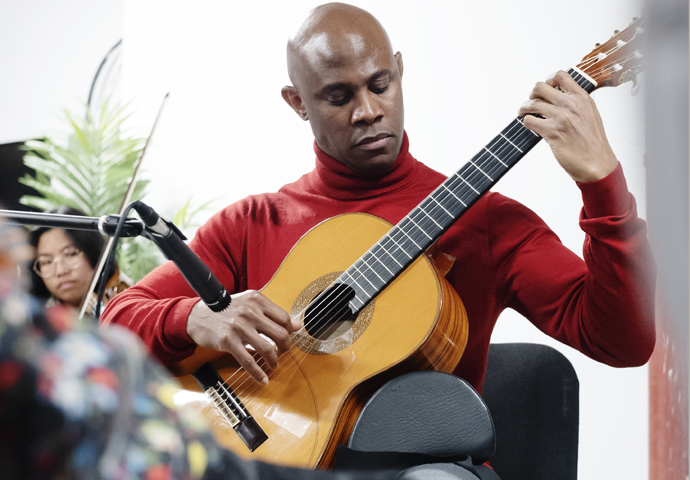Classical echoes
The annual Echoes Festival celebrates South America’s classical music legacy, as Cristina Lago reports
Friday, 16th December 2022 — By Cristina Lago

Ahmed Dickinson performing at the Echoes Festival in November. Photo: Jill Furmanovsky via rockarchive.com
LATIN America is celebrated as the birthplace of well-known music genres such as rumba, tango or bossa nova. Latino sounds thrive in London, home to 145,000 Latin Americans, and there’s no need to look far to find lively reggaeton or salsa concerts in some of the capital’s main venues.
But South America has also a rich classical music legacy spanning more than 500 years – a legacy mostly unknown to UK audiences.
Ambassadors of Latin American culture have usually prioritised popular and indigenous music as the real expression of the peoples from the countries in the region. Classical music, even that created by Latin American composers, is often associated with the oppressive colonial culture imposed by European powers for over five centuries since the invasion of the conquistadors.
However, not everyone agrees. Some argue that promoting Latin American classical music, unique in itself for the way it has developed among the rich indigenous cultures, presents an opportunity to challenge the Eurocentricity and white hegemony of this music genre.
That is at least the stand of Echoes Festival – an annual event organised by the Iberian and Latin American Music Society (ILAMS) and the Cervantes Institute showcasing the vast classical music tradition of Latin America, as well as Spain and Portugal.
The festival launched in London in 2016 with the mission to “decolonise classical music” and “fill a conspicuous gap” in the UK’s music programming with Latin American and Iberian classical pieces, including the important but often unrecognised legacy of Indigenous and black Latin American composers.
Although black classical music composers previously ignored by the Anglosphere canon are now featuring in the programming thanks to the repercussions of Black Lives Matter activism, Afro-Latin artists and music are still mainly forgotten and have been left out of this movement, says Helen Glaisher-Hernández, Echoes Festival’s artistic director:
“You don’t see many works by black Latin American composers being programmed still and you don’t hear much classical music from Latin America, Africa or Asia,” she says.
Some of the artists featured in the festival include Paraguayan classical guitarist and composer Agustín Barrios, Cuban-French violinist and composer José White, or the Brazilian composers Catarina Domenici and Chiquinha Gonzaga. During this year’s edition, “ambassador” of Latin-American piano music Clara Rodríguez played pieces by Venezuelan and Latina women composers, including the work of Modesta Bor – a key Venezuelan composer practically unknown in Europe.
The last of this year’s concerts featured classical guitarist Ahmed Dickinson, who launched the new Echoes Festival African Diaspora Series in collaboration with the Salix Quartet at London’s Africa Centre with the aim to explore contemporary Afro-Cuban music for guitar and strings.
The evening featured pieces by some of Cuba’s most dynamic composers, including the UK premiere of Moforibale a Ochún by Walfrido Domínguez – a soulful work inspired by the music of Yoruba religious offerings.
By juxtaposing European and non-European repertoires in the festival’s programme, Glaisher-Hernández and her colleagues want to shine a light on the Latin American influences and “echoes” which are also present in European classical music.
Unlike their counterparts in Europe, classical music composers in Latin America have been actively engaged for centuries in regional popular music that has inspired their own writing.
“It’s not like here in Europe, where composers either write classical or popular music,” explains Glaisher-Hernández. “Here, it’s very difficult to find examples of people who write both popular and classical music. In Latin America that’s completely normal.”
This incorporation of popular music elements was vividly felt in Música de la Tierrita (Music from the Homeland), a concert of Colombian music for flute and guitar by the Correa Andrews Duo. The colourful programme, which included pieces by the Saboya brothers, Santiago Bernal, and Luis Uribe Bueno, among others, provided examples of the rich geographical and cultural diversity existing in Colombia, and how classical music and folk can live hand in hand.
In Graffiti No1, by Jorge Andrés Arbelaez, the duo explored the Andean rhythms of Colombia, including the bambuco, pasillo and guabina. Moving away from the mountains and into the plains shared with Venezuela, a joropo by Heraclio Fernández titled El Diablo Suelto (The Devil Unleashed) showed the mastery that Latin American composers have at the time of incorporating regional folk into traditional classical music.
This incorporation of popular music elements has the ability to make classical music more accessible and inclusive to all kinds of audiences. Which maybe explains why the venue at the Cervantes Institute, where Música de la Tierrita took place, was packed with a congregation that included children to elderly people.
Glaisher-Hernández adds that it also provides a tool for composers to challenge the notion of classical music being an exclusive genre for the highly educated: “It’s a way for them to fight back by making classical music less elitist.”